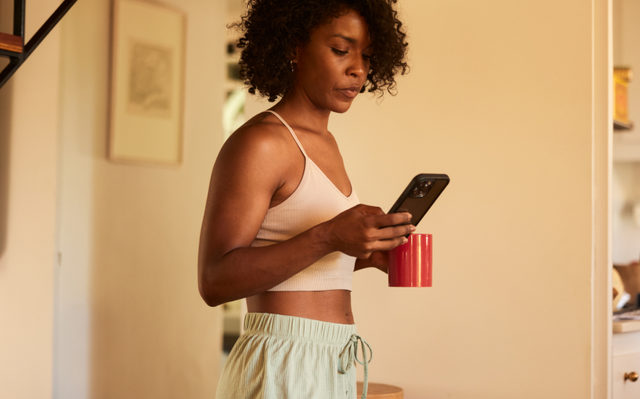Here at Modibodi, we like to stay open and curious about alternative remedies, especially when it comes to naturally supporting our menstrual cycles. Seed cycling is a naturopathic remedy where you eat certain types of seeds at different phases of your cycle to help balance hormone production.
While there isn’t a wealth of scientific research on seed cycling, some menstruating people have noticed positive changes to their hormonal symptoms when trying it.
Think it’s all just hype? Or confident that there’s a grain of truth behind this ancient practice turned modern trend? Whatever your stance, we’re here to answer all the big q’s – from what it is and how it can benefit you to whether or not it actually works.
Before we get started, here’s a speedy refresher on the different phases of your menstrual cycle so that we know what we’re dealing with.
Understanding your cycle: let’s talk hormones
Hormones play a big role in regulating your menstrual and ovarian cycles. At every phase, different hormones get released, and when this well-formulated balance gets thrown off course, it can cause a few issues.
Let’s go back to PE class for a sec and talk anatomy. There are 4 distinct phases to your menstrual cycle – the follicular phase, ovulation, the luteal phase, and, of course, menstruation. For the purpose of seed cycling, we’re going to focus on the follicular and luteal phases and shine the spotlight on the well-known duo of progesterone and estrogen.
The follicular phase kicks off on the first day of your period and lasts until ovulation, usually around 14 days. Throughout this phase, your estrogen levels rise, prompting the lining of your uterus to thicken in preparation for a potential pregnancy. It’s at this time that progesterone takes a back seat.
The luteal phase starts after ovulation and lasts until your next period. This phase typically lasts for another 14 days, but it can vary. During this time, progesterone levels rise and estrogen levels slowly decline.
When these hormones fall out of step with one another, it can lead to mood swings, irregular periods, heavy bleeding, PMS, missed periods – you get the drift. These hormones rule the roost (normal, everyday life be damned) and unapologetically so, which is why we’re keen to explore the methods and merits behind the modern concept of seed cycling. Let’s get started.
What is seed cycling?
The theory behind seed cycling is that it supports and regulates the production of estrogen in the first half of your cycle and the production of progesterone in the second half. In doing so, it’s meant to help reduce those wish-this-wasn’t-happening-to-me symptoms that arise when our hormones stop doing their happy dance.
Here are the 2 phases of seed cycling and the recommended seeds to consume during these periods.
- The follicular phase (days 1–14 of your cycle): 1–2 tablespoons of ground flax seeds and 1–2 tablespoons of ground pumpkin seeds.
- The luteal phase (days 15–28 of your cycle): 1–2 tablespoons of ground sunflower seeds and 1–2 tablespoons of ground sesame seeds.
Now that you’re familiar with what you need to be popping into your trolley the next time you’re out on your grocery run, let’s delve into the science behind these little kernels to see how they actually work.
Seed cycling for hormones
The research into the correlation between seed cycling and achieving better hormonal balance during our periods is still in its infancy. There are, however, studies that suggest that certain nutrients found in flax, pumpkin, sesame and sunflower seeds might play a role in supporting healthy hormonal cycles. Let’s take a closer look.
- Flaxseeds are high in lignans, something that can help to grab onto extra estrogen and keep things balanced. They can also make your luteal phase longer, help you ovulate better and ease period symptoms like sore breasts and cramps.
- Pumpkin seeds are loaded with zinc, which is a key player in making the corpus luteum. This little structure in your uterus pumps out progesterone and helps your lining get ready for a possible pregnancy.
- Sesame seeds have lignans too, and they can help keep extra estrogen in check during the second half of your cycle when progesterone is calling the shots. Plus, if you’re going through menopause, sesame seeds might help with matters around cholesterol, antioxidants and sex hormones.
- Sunflower seeds have a mineral called selenium that’s a great helper when it comes to getting rid of excess estrogen. This is especially important during the luteal phase, when estrogen goes down and progesterone goes up. By keeping estrogen levels from getting too high, selenium can help you feel like your best self.
How to incorporate seed cycling into your daily routine
Not loving the idea of sculling a tablespoon of ground-up seeds every morning? Yeah – neither are we. Here are some tried and tested ways of working in your own seedy concoctions into your daily meals.
- Add your seed mix to your morning smoothie to give your drink a creamier, richer feel.
- Throw some in with your oatmeal or cereal, and Bob’s your uncle.
- Sprinkle them over a lunchtime salad or nourish bowl for added seasoning and crunch.
- Stir in a ground-up medley into your favourite soups and stews for that warm, earthy goodness.
Does seed cycling help balance hormones?
Laura Kelly tried seed cycling to help combat painful, heavy periods and PMS symptoms that she had been experiencing since she was a teenager. She says the method gave her peace of mind when it came to certain parts of her cycle.
“With the support of an integrative doctor, I started researching lifestyle changes that might help balance my hormones,” she explains. “That’s when I came across seed cycling, and I found it pretty easy to start adding seeds to my morning smoothies.”
“I did notice some changes in the first couple of months – reduced period pain and emotions that felt a bit more stable in the week leading up to my period. But there was no change in the heavy bleeding.
“At the same time,” she continues, “I was making other lifestyle changes like cutting down on sugar and caffeine to help support my hormones. And while I definitely noticed a positive impact, in the end I stopped taking the seeds.”
She explains that while they did no harm, it was hard to know if they were the sole reason for the changes she had been experiencing.
Take care of your cycle
Seed cycling may not be the secret sauce to all your hormone-related problems, but it’s a natural remedy worth considering. And it’s on par with maintaining other lifestyle factors such as good sleep, good stress management, nutritious eating, healthy hydration and a reduced exposure to hormone-disrupting toxins.
As always, if you’re concerned about any of your symptoms it’s best to speak to a trusted healthcare practitioner who can ensure you’re getting the support you need.






